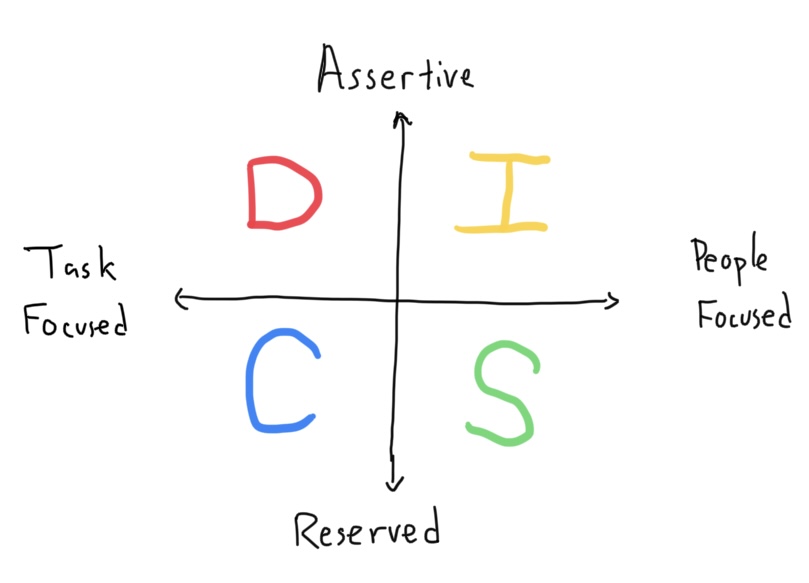DISC
DISC is an incredibly powerful tool for relating to people.
What is DISC?
At a high level, DISC is a very simple framework for understanding differences between how people approach the world. DISC may sound similar to a Meyers-Briggs personality test, but the genius of DISC is in its simplicity and structure.
The core of DISC is two questionsTechnically, the science behind DISC asks two slightly different questions: “do you see your (social) environment as favorable or unfavorable” and “do you see yourself as more powerful or less powerful than your (social) environment.” The “favorable/unfavorable social environment” question corresponds to the “people/task focused” question and the “more/less powerful than social environment” question corresponds to the “assertive/reserved” question. I find the latter framing more intuitive and memorable as a teaching tool.
:
- Are you more people focused or task focused?
- Are you more assertive or reserved?
There is no right and wrong answer to these questions: they were deliberately chosen to divide the world into equal sized parts. When put together into a 2x2 grid, we end up with 4 quadrants that correspond to 4 equally common and valid approaches to the world:

We have a number of ways to refer to each quadrant:
- Most commonly, we just refer to the letter “D,” “I,” “S,” or “C.”
- We can also use the corresponding word (“Dominance,” “Influence,” “Steadiness,” and “Conscientiousness”). In practice, this is less common; the words are abstract and sometimes confusing.
- I believe the Insights tool maps to DISC and uses a color for each quadrant: “Fiery Red” for “D,” “Sunshine Yellow” for “I,” “Earth Green” for “S,” and “Cool Blue” for “C.”
- Sometimes we’ll describe the location on the axes: “people focused amd assertive”
When someone takes a DISC test, they receive a score for each of the quadrants. If they have a high score in one quadrant, we refer their DISC profile as being “high I” or equivalent. It is possible and reasonably common for people to have 2 high quadrants (e.g. “high D and high I”). The multiple quadrants are almost always on the same side of an axis; they are almost never diagonally opposed.
What do the different quadrants mean?
I’ll give a description of each quadrant in DISC from Manager Tools.
The people in the top-left quadrant are the “high Ds” in DISC: they are task focused and assertive. They are laser focused on results; they are the drill sergeants of the world.
These are the forceful, take no prisoners, rough around the edges folks. They like to get immediate results, make quick decisions, cause action, take authority, solve problems. Unfortunately, other folks often see High D’s as intimidating, unapproachable, insensitive, and impatient. (Horstman and Auzenne 2014)
The people in the top-right quadrant are the “high Is” in DISC: they are people focused and assertive. They are brimming with enthusiasm; they are the sales people of the world.
They network well, smile, shake hands, inspire others, love to lead groups, have a million friends, and believe image matters. Unfortunately, others often see I’s as not detailed enough, lacking organization, and as starting lots of things but finishing few. (Horstman and Auzenne 2014)
The people in the bottom-right quadrant are the “high Ss” in DISC: they are people focused and reserved. They care about supporting each other; they are the nurturing family members of the world.
They are great team players, and believe in loyalty and harmony. They are empathetic, good listeners. Unfortunately, others see S’s as indecisive, and indirect, and often unwilling to change (Horstman and Auzenne 2014)
The people in the bottom-left quadrant are the “high Cs” in DISC: they are task focused and reserved. Their chief concern is accuracy; they are the monks and accountants of the world.
They are thorough, and accurate, and know their details. They are careful, and because they tend to play their cards close to the vest, are often wonderful as diplomats. Unfortunately, others can see C’s as perfectionists, unwilling to bend at all, stuck on details versus the big picture, and they come across as cool, or aloof in their dealings with others. (Horstman and Auzenne 2014)
The real power in DISC is in its simplicity and structure. Since it only has 2 axes, I can keep the whole model in my head at once. Unlike, say, Myers Briggs
My focus turns to the relationships between quadrants rather than the quadrants themselves. The structure of DISC makes these relationships predictable: Unlike, say, True Colors
a high D and a high C show their assertive/reserved tendencies through an age-old conflict about taking action now versus measuring first.
DISC is an incredible tool for understanding, predicting, and improving the relationships between people.